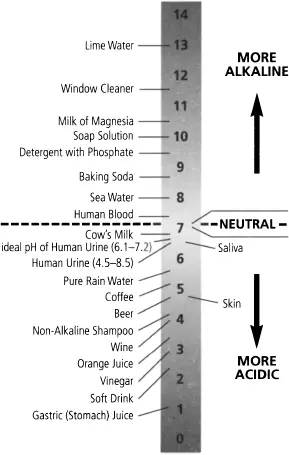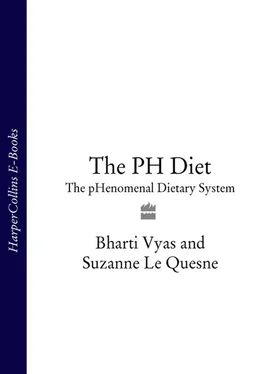Check your symptoms:
• Frequent infections, caused by a suppressed immune system: yeast infections, such as candida; parasitical infections; and bacterial and viral infections, such as colds and flu
• Low energy or chronic fatigue
• Aching muscles or joint pain; rheumatoid arthritis, osteoarthritis, gout or fibromyalgia
• Osteoporosis, weak, brittle bones; hip fractures or bone spurs
• Bladder or kidney problems, such as kidney stones
• Dull skin, brittle nails and hair
• Premature lines and wrinkles
• Liver or ‘age’ spots
• Acne, eczema or psoriasis
• Poor concentration or forgetfulness
• Excess weight, obesity
• Type II diabetes
• Mood swings
Our body tries its best to get rid of acidic residue left by acid-forming foods through urine, sweat and exhaled breath. However, our kidneys, skin and lungs can only cope with so much. They often become exhausted and cannot break down all the wastes from acid-forming foods, drinks and stimulants.
When this happens, what can’t be processed has to be stored somewhere in the body. In order to live healthily, our blood and cells must always remain slightly alkaline. So the body, always pursuing survival, changes leftover acidic wastes into solid wastes and stores them.
Here are some examples of solidified acidic wastes:
• LDL cholesterol (the harmful cholesterol that can build up on artery walls)
• Adipose tissue (AKA fat)
• Uric acid (responsible for gout, kidney stones and gallstones).
The accumulation of these solid wastes can also be described as the ageing process and the cause of disease. When you eat abundant alkaline-forming foods you’ll be able to excrete acid wastes far more effectively, and powerfully assist your whole body to function more efficiently. When your body is working in this way, weight loss is easy, symptoms disappear and good looks and health abound.
Most people who suffer from an unbalanced pH have too much acid in their bodies, a condition known as acidosis. This forces the body to ‘borrow’ minerals – including calcium, sodium, potassium and magnesium – from vital organs and bones to buffer the acid and safely remove it from the body. Because of this strain, the body can suffer severe and prolonged damage, and the condition may go undetected for years.
Acidosis is the foundation of many everyday symptoms like fatigue, poor skin, weak and brittle nails and difficulty in losing weight, as well as the many symptoms, illnesses and diseases listed in the box (see page xii). When you alkalize your body by following The pH Diet , you’ll be able to restore and maintain your overall health and beauty.
So which foods are acid-forming?
One of my clients, with whom I’d been discussing acid- and alkaline-forming foods, expressed this important concern about what she should eat. ‘What about lemon and lime?’ she began. ‘They’re acidic yet they’re antioxidants, and good for you.’ This is a common assumption – that what tastes acidic stays acidic during digestion. However, the pH value of a food or drink isn’t always the same as its acid-or alkaline-forming tendency in the body. It’s what happens after we eat and drink that counts. ‘Acidic’ limes or lemons actually produce an alkaline residue in our bodies – the opposite of what we would expect. Likewise, meat doesn’t taste acidic at all, but it leaves a very acidic residue in our bodies after digestion. So, like nearly all animal products, meat is very acid-forming.
All foods can be categorized as acid-forming, alkaline-forming or neutral. Water is neutral, against which all other foods and drinks are measured. To help you get your body back into pH balance, see the listing of acidic-forming foods and drinks to avoid (page 104) plus all the alkaline-forming super foods you’ll need to eat your way to great health, energy and weight loss.
But I already eat healthy foods …
James, a client, had been feeling overweight and listless. In fact, his tiredness had been going on for so long that he admitted to me that he had almost become used to it. And the more tired he felt, the less he wanted to work out at the gym; and the more he used stimulants such as coffee and biscuits during the day to pep himself up. Otherwise, he thought he ate an excellent diet – lots of lean meat, potatoes, some vegetables.

pH Values of Some Common Liquids
On closer examination of James’ eating habits, I explained to him how many of his favourite foods were acid-forming – and how his body could only fully assimilate nutrients when it’s pH balanced. If your pH is too acidic you can eat healthy food packed with vitamins and minerals, yet get little or no health benefits. The goodness in food can’t be absorbed in the gut because of the acidity there, so the nutrients are wasted. This helped to explain James’ tiredness – he was nutrient-deficient because of his ‘acid’ diet. By changing to the pH Diet, he was able to break the tiredness cycle, cut out the stimulants and enjoy better health. He lost 5lbs in the process.
Getting the balance right
By eating enough alkaline-forming foods, you’ll be able to establish and maintain a good acid/alkaline balance in your body. This is vital for good health, because acid-forming foods are inflammatory, whereas alkaline-forming foods are anti-inflammatory. So eating alkaline-forming, anti-inflammatory foods will give your body a tremendous boost. Acid-forming, inflammatory foods, however, may have only detrimental effects on the body. Below are examples of some common dietary habits that cause acid overload:
• A high-protein diet
• Eating lots of refined carbohydrates, such as bread and pasta
• Eating few vegetables and fruits
• Drinking high levels of alcohol
It’s easy to see from the list above that none of these eating patterns provides a balanced diet. A balanced diet means getting the correct proportion of nutrients for health and vitality. The balance of carbohydrates, fats and proteins is important, but if you balance your diet between acid- and alkaline-forming foods by following the pH diet, you’ll automatically get a balance of foods from the three major food groups. You won’t feel deprived by forgoing all your carbs, or eliminating foods such as nuts because they’re high in fat: with the pH diet, you’ll regain your body’s natural acid/alkaline balance, and get all the nutrition you need.
What about high-protein diets?
High-protein diets have become popular recently because they help people lose weight successfully. However, the long-term effects of diets such as these are not beneficial. Clinical studies have shown them to be a precursor to osteoporosis (brittle bone disease). In the short term, a high-protein diet will cause constipation, bad breath and low energy levels due to insufficient fibre and carbohydrate levels.
The urine of someone who regularly eats high-protein foods often gives an alkaline reading. However, this is misleading. When excess protein is consumed, the body releases calcium and magnesium from the bones and organs to neutralize the acids. As more and more minerals are taken from the bones, the weaker they become. A diet high in protein must therefore be considered with caution.
Читать дальше













